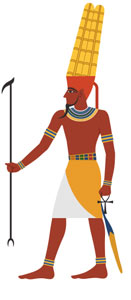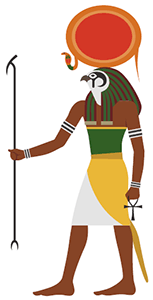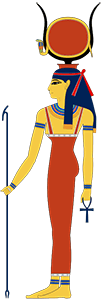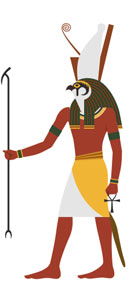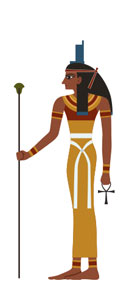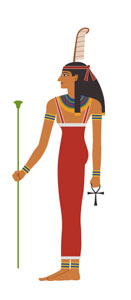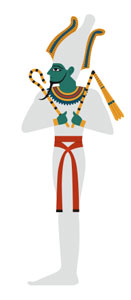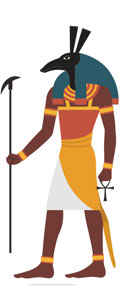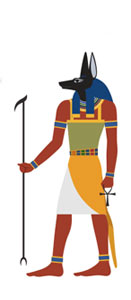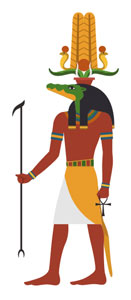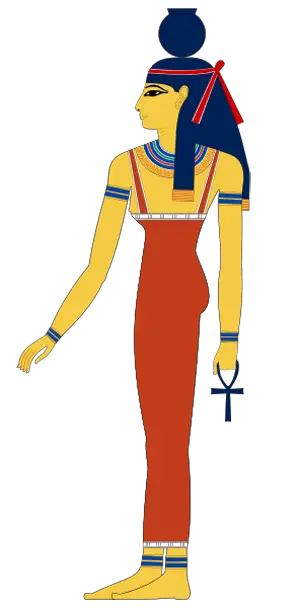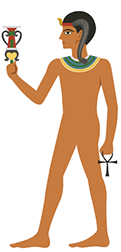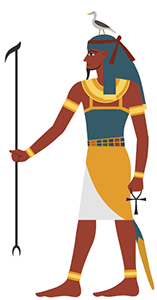The Ancient Egyptian Gods
Except for a brief period of time when Akhenaten tried to instill a monotheistic dedication to one god, Egypt was ruled by numerous gods and goddess. The ancient Egyptian religion was polytheistic, meaning the ancient Egyptians worshiped many gods (there are about 2000 known gods and goddesses).
The gods played important roles in the daily lives of the ancient Egyptians. There were two levels of gods: local gods and national gods. People looked to the gods for help with everything from bearing children to a safe journey in the afterlife. There were daily rituals for caring for the gods and festivals celebrating specific gods.
Some of the Most Important Egyptian Gods and Goddesses
Amun was a creator god who became a national god after the pharaohs moved their capital to the city of Thebes. He was later combined with Ra, who was a sun-god, a creator god and the king of the gods. The people saw Amun-Ra as the creative power behind the existence of all life. He was primarily considered to be the god of the pharaohs and represented wind, fertility and secrets.
Ra is the ancient Egyptian sun god. He is the father of the gods and is usually depicted with the body of a human and the head of a falcon.
Hathor was a cow goddess and a cosmic goddess. She nourished all life with her milk and her name meant “House of Horus”. Some legends, name Hathor as the consort of Horus and she formed a Triad with him and their son Ihi.
Horus was a sun god and the king of the gods. “The living Horus” was one of the pharaoh’s titles and emphasized his right to rule Egypt like Horus ruled the gods. His emblem was the falcon and he was one of the five Osirian gods along with Osiris, Isis, Set and Nephthys. One of the most well known symbols associated with Egypt is the Eye of Horus, which symbolized power.
Isis was a fertility goddess and a mother goddess. The goddess with 10,000 names was one of her titles emphasizing her many roles and names. She was the sister-wife of Osiris and the mother of Horus. One of the most famous legends involves Isis putting the body of her husband back together after he was killed by Set, impregnating herself with his body and giving birth to their son Horus.
Ma’at was the representation of moral and physical law. Some scholars consider her the most important goddess of Ancient Egypt. Ma’at’s worship spread throughout Egypt because she helped judge the dead.
Osiris was the god of the dead and resurrection. He was the ruler of the Tuat and people would appeal to him to care for their departed ancestors. Osiris was the king of the gods until his brother killed him.
Seth (aka Set, Setesh, Sutekh or Setekh) was the god of evil and darkness. He was the adversary of Horus and everything that was good. Except for the red crown, people regarded the color red as an evil color because of its connection to Set. He was associated with war and strength, storms and deserts.
Anubis is the god of death and dying. He is also considered to be the god of the underworld. His image is often seen as the guardian of tombs and the bodies held within.
Sobek the crocodile god is usually seen as either a complete crocodile or as a combination between human form and crocodile, symbolizing the strength of the Egyptian pharaohs.
Click here for a list of the 30 most Famous Ancient Egyptian Gods...
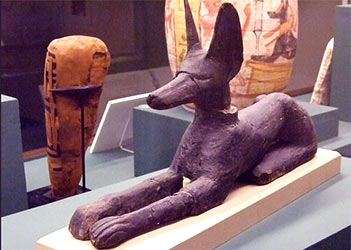
© Mary Harrsch - Anubis Statue
The Appearance and Roles of the Gods
The gods filled roles that held importance to the worshipers and many deities were only worshiped in a single location. For example, women would worship Isis because she was a mother and they wanted her to bless and help them. These roles helped create a connection between the people and the god.
Many of the gods of ancient Egypt had unique appearances, but there were some common features. Most depictions show the gods in human form or as humans with animal heads. These images also used repeating symbols. It can be difficult to tell some of the gods apart because they use the same symbols.
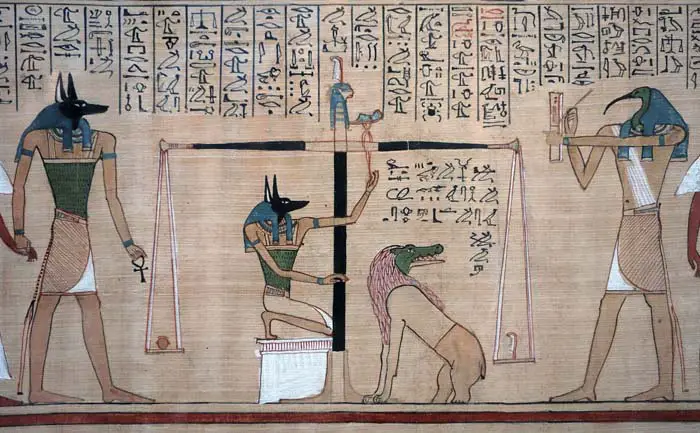
© Steven Zucker - Depictions of Gods in Hunefer's Book of the Dead
List of Common Symbols
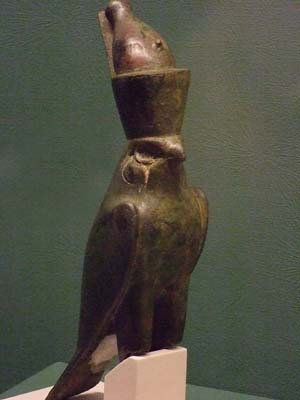
© Mary Harrsch - Falcon representing Horus
- Animals: the animal heads given to a deity were often connected to his/her roles (i.e. hawk heads for sun gods; cat head for bastet)
- Ankh: hieroglyph for life that a god held in one hand
- Atef crown or headdress: crown shaped like the white crown with a small sun disk on top and feathers on each side
- Double crown: the combined crown of Upper and Lower Egypt that signified its unification
- God scepter: a scepter topped by Set’s animal head with a forked bottom
- Goddess scepter: the lotus scepter or papyrus scepter
- Red crown: the crown of Lower Egypt with a long curl, it signified the vulture and the goddess Nekhbet
- Sun disk: emblem of the sun worn by various deities that the uraeus might encircle
- Uraeus: the divine cobra that was the symbol of the goddess Buto
- Vulture goddess headdress: resembled a vulture lying on the head
- White crown: crown of Upper Egypt that looks like a mitre with the uraeus on the front
Legend of the Creation of the World
At first, nothing existed except Nun, the celestial waters. Ra sprang from Nun with words on his lips and those words created the first firmament. Then he created his daughter Tefnut from his spit and his son Shu from his breath. They lived together until Tefnut and Shu wandered away and Ra missed them. He plucked out his eye and sent it to find his children. Then Ra created a new eye for himself so he would be able to see his children.
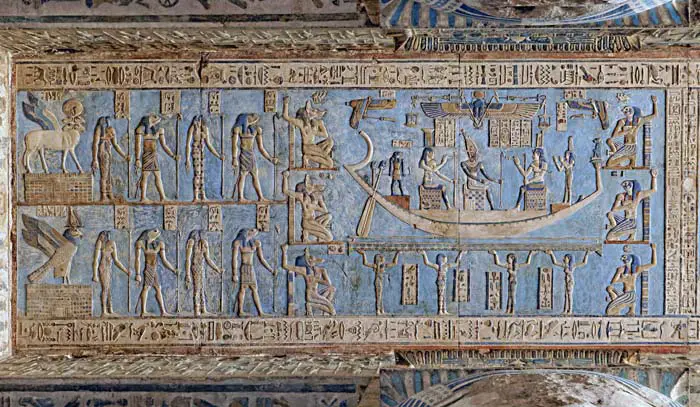
© kairoinfo4u - Ceiling at Dendera Temple, describing the creation of the world
The old eye found Tefnut and Shu and brought them back to Ra who cried with joy. His tears fell and created the first humans. The old eye was jealous of Ra’s new eye, so Ra turned the old eye into the first cobra and wore it on his forehead. Tefnut and Shu mingled together and gave birth to Geb and Nut. Shu separated his children to form the sky, Nut, and the earth, Geb. Ra became a ball of fire and rolled over Nut creating the pattern of day and night. After this, all other creatures and all plants came into being.
The Importance of the Gods in Ancient Egypt's Daily Life
Daily rituals took place at the local temples to care for the gods which, the king or a high priest conducted. As part of the ritual, the king or priest washed the image of a certain god, clothed it in fresh garments, and gave it a meal. The meal consisted of various kinds of meat and vegetables which the priest shared with the temple staff after the ritual. Burnt offerings were a rarity in ancient Egypt.
Festivals were a time for everyone to worship the gods and goddesses of ancient Egypt. Images of the gods progressed through the city in a barque, a small boat. The common people gathered in the outer courtyard of the temple and gave offerings. People offered flowers because they represented life, as well as food and drink. The priests gave portions of the food offerings to the common people. Many festivals to the deities took place throughout Egypt and were a public holiday.
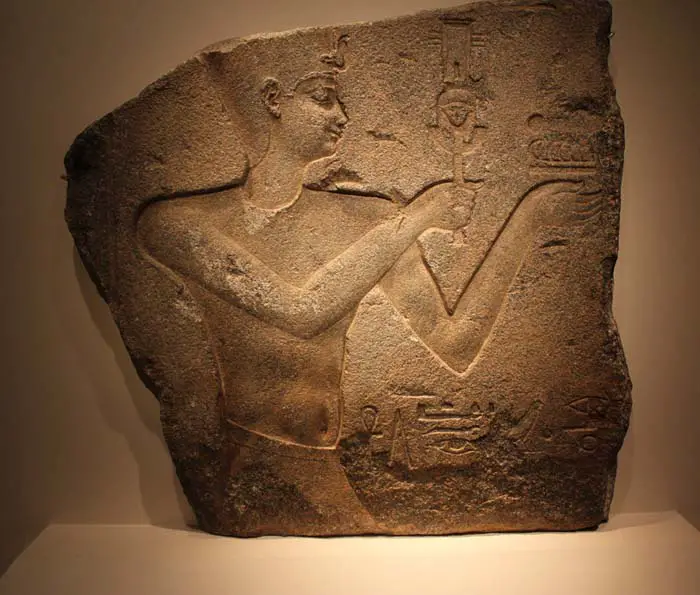
© Daniel DeCristo - Relief of Ptolemy II with ritual rattle
Private individuals served the gods in various ways. Many private homes had shrines where the family worshiped household gods. These gods protected the home and its occupants. Common people also presented votive offerings to the gods at their local temples. Votive offerings were statuettes, steles, or carved plaques that included a prayer to the god or a hymn praising the deity. Worshipers placed these offerings in the main courtyard of the temple. When the priests needed more room to place them, they buried the votive offerings in pits. These pits have provided scholars with information about the worship of the common people. Votive offerings show the rise in personal piety among the people of ancient Egypt.
Another important part of worship involved the offerings to the dead. Relatives would offer bread, beer, oxen, birds and clothing to the god Osiris. They included prayers with these offerings so the god would share them with their dead relatives. There were special altars designed to accept these offerings.
People also interacted with the gods through oracles, prayers and hymns. During the processions of the ancient Egyptian gods, people would write a question on a piece of pottery or papyrus. A person placed the question before the god’s image. The god compelled the priests carrying the barque to move forward or backward to show a yes or no answer. People wrote prayers to the gods to ask for protection or to honor the gods. Hymns honored the gods by praising their deeds or their beauty.
Specific people conducted the religious ceremonies in the temples. Many wall carvings show the king caring for the god’s image and conducting ceremonies. Records state that the king did conduct ceremonies but he could not serve every deity. The High Priest of the temple would conduct ceremonies in the king’s place. During the 21st Dynasty, the role of ‘god’s wife of Amun’ became a powerful priestess position. Over time, these women came to present offerings to the gods and to conduct ceremonies.

